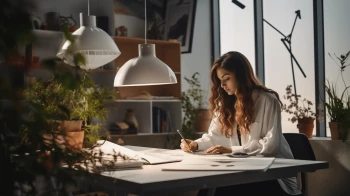Your living space is a reflection of your personality, style, and comfort. Whether you're moving into a new home, planning a renovation, or simply looking to refresh your current surroundings, the expertise of a professional interior designer can make a world of difference. While many individuals may be tempted to take on the task of designing their spaces independently, there are numerous reasons why enlisting the services of a professional is a wise investment. In this article, we will explore the benefits of hiring a professional interior designer and how their expertise can transform your living space into a personalized oasis.
Personalized Design Concept:
Creating a truly personalized living space goes beyond arranging furniture or choosing color schemes—it involves crafting an environment that resonates with your personality, preferences, and lifestyle. Professional interior designers are adept at the art of tailoring a design concept to suit your individual needs, offering a level of customization that is both nuanced and transformative.
1. In-Depth Client Consultation:
Professional interior designers initiate the design process with a thorough client consultation. This involves delving into your lifestyle, daily routines, and aesthetic preferences. They ask the right questions to understand how you envision your space and what elements are essential for your comfort and satisfaction. This initial dialogue lays the foundation for a design concept that is not only visually appealing but also aligned with your practical needs.
2. Translating Ideas into Design Elements:
Armed with a wealth of knowledge and experience, designers can effortlessly translate your ideas into tangible design elements. Whether it's a specific color palette that resonates with you, a particular design style you adore, or functional requirements for specific rooms, they have the expertise to integrate these aspects seamlessly into the overall design. This ensures that your space is not just aesthetically pleasing but also practical and functional.
3. Custom Furniture and Fixtures:
A key aspect of personalization lies in the selection of furniture and fixtures. Professional interior designers often have access to custom-made pieces or exclusive designs that perfectly align with your vision. They curate a selection of furnishings that not only complement each other but also fit the dimensions and requirements of your space. This level of attention to detail elevates the design concept to a bespoke, one-of-a-kind creation.
4. Balancing Form and Function:
Beyond aesthetics, designers understand the importance of balancing form and function. They skillfully integrate design elements that not only look good but also serve a practical purpose. Whether it's optimizing storage solutions, creating multipurpose spaces, or enhancing natural lighting, every design decision is made with a keen awareness of how it contributes to the overall functionality of your home.
Space Optimization:
Professional interior designers are masters at maximizing the functionality and aesthetics of a space, turning ordinary rooms into harmonious environments that seamlessly blend practicality with visual appeal. The skillful art of space optimization is a hallmark of their expertise, encompassing various elements that transform your living area into a well-utilized and aesthetically pleasing haven.
1. Strategic Furniture Placement:
Interior designers possess an acute sense of spatial awareness, allowing them to strategically place furniture for optimal flow and functionality. They consider the proportions of each room, the placement of doors and windows, and the traffic patterns within the space. This thoughtful approach ensures that each piece of furniture serves its purpose without overwhelming the room or impeding movement.
2. Customized Storage Solutions:
Efficient storage is crucial for maintaining an organized and clutter-free living space. Designers have a knack for identifying underutilized areas and incorporating custom storage solutions. From built-in shelving to hidden cabinets and multipurpose furniture, these design elements not only enhance the visual appeal of the space but also provide practical solutions for storing belongings.
3. Open Concept Design:
Embracing open-concept design is a popular trend in modern interiors, and professional designers are adept at implementing it to create the illusion of more space. By removing unnecessary walls and barriers, they enhance the flow of natural light and promote a sense of expansiveness. This design strategy is particularly effective in smaller homes, where it can make a significant impact on the perceived size of the living areas.
4. Color and Lighting Techniques:
The strategic use of color and lighting can profoundly impact the perception of space. Designers leverage these elements to create an illusion of depth and openness. Lighter color palettes, strategic placement of mirrors, and well-designed lighting fixtures contribute to an airy and spacious feel. Conversely, darker colors and specific lighting techniques can be employed to create coziness and intimacy in larger spaces.
5. Flexible Furniture Arrangements:
Professional interior designers understand the importance of adaptability. They often incorporate furniture arrangements that can be easily reconfigured to accommodate different activities or events. This flexibility ensures that your living space remains dynamic, evolving to meet the changing needs of your household.
6. Attention to Proportions:
Understanding the proportions of furniture in relation to the size of the room is crucial for effective space optimization. Designers carefully select furnishings that complement the scale of the space, avoiding overcrowding or sparse arrangements. This attention to proportion creates a balanced and harmonious environment.
7. Zoning and Room Division:
Large or multifunctional spaces benefit from strategic zoning and room division. Designers employ creative solutions such as area rugs, furniture groupings, or architectural elements to define distinct zones within a room. This not only adds visual interest but also enhances the functionality of the space.
Access to Quality Resources
Engaging the services of a professional interior designer grants you access to a treasure trove of resources that extend far beyond the usual options available to the general public. This advantage lies not only in the aesthetic appeal of exclusive furnishings and materials but also in the quality and craftsmanship that define these elements. Let's delve into the details of why this access to premium resources is a pivotal aspect of the interior design process.
1. Exclusive Furnishings and Custom Pieces:
Interior designers often collaborate with renowned furniture designers and manufacturers, granting them access to exclusive furnishings and custom pieces. These unique items can become statement pieces within your home, adding an element of individuality that goes beyond what is commonly available in retail stores. The result is a living space that is not only stylish but also a reflection of your distinct taste.
2. High-Quality Materials and Finishes:
Beyond aesthetics, the quality of materials used in your home plays a crucial role in its longevity and overall appeal. Professional interior designers have an extensive knowledge of materials and finishes, allowing them to select the highest quality options for your project. From luxurious fabrics to durable flooring materials, their expertise ensures that your home is adorned with elements that stand the test of time.
3. Expert Curation of Decor Items:
Interior designers are adept at curating decor items that enhance the overall design concept. Whether it's selecting unique artworks, statement lighting fixtures, or bespoke accessories, their access to a diverse range of suppliers enables them to choose items that perfectly complement the design aesthetic. This curated approach ensures that every detail contributes to the cohesive and polished look of your home.
4. Established Supplier Relationships:
Professional interior designers often have longstanding relationships with a network of suppliers, artisans, and craftsmen. These relationships are built on trust and reliability, allowing designers to source materials and furnishings efficiently. This established network not only streamlines the procurement process but also provides access to the latest design trends and innovations in the industry.
Cost-Efficiency:
The misconception that hiring a professional interior designer is a costly luxury is a myth that fails to consider the long-term savings and value-added benefits they bring to the table. Professional interior designers are not just aesthetic visionaries; they are strategic thinkers who contribute to a more cost-effective and efficient design process. Let's delve into the details of why investing in their expertise can actually be a financially prudent decision.
1. Prevention of Costly Mistakes:
The journey of designing a home is riddled with potential pitfalls and costly mistakes, especially for those without professional guidance. From choosing the wrong paint color to investing in furniture that doesn't fit the space, these errors can lead to unnecessary expenses. Interior designers, armed with their knowledge and experience, have a keen eye for detail, preventing costly mistakes before they occur. This foresight not only saves money but also ensures that your investment is directed toward elements that enhance the overall design.
2. Strategic Budget Allocation:
Designing a home involves budgeting for various elements such as furnishings, materials, and labor. Professional interior designers are adept at strategically allocating your budget to achieve maximum impact. They prioritize key elements based on importance, directing funds to areas that will have the most significant impact on the overall design. This results in a well-balanced and aesthetically pleasing space without unnecessary overspending.
3. Efficient Use of Resources:
Designers possess the expertise to optimize the use of resources, ensuring that every aspect of the design contributes to the desired outcome. From space utilization to the selection of materials, their knowledge allows for a more efficient use of resources, minimizing waste and maximizing the value of your investment.
4. Project Management Expertise:
The efficient management of a design project is a crucial aspect of controlling costs. Interior designers excel in project management, coordinating various elements of the design process, from liaising with contractors to overseeing timelines and deliveries. Their organizational skills contribute to a smoother workflow, reducing the risk of delays and associated costs.
Time-Saving:
Embarking on a journey to design or redesign your living space can be an exciting yet time-consuming endeavor. This is where the invaluable role of a professional interior designer becomes evident, as they possess the expertise to streamline the design process, making it not only more efficient but also less demanding of your time. Let's explore how the time-saving brilliance of a designer contributes to a smoother and more timely realization of your design vision.
1. Efficient Decision-Making:
Designing a space involves a multitude of decisions, ranging from color palettes to furniture styles and finishes. The wealth of experience that interior designers bring to the table allows them to make decisions efficiently. They have a keen understanding of design principles, trends, and compatibility, enabling them to guide you through choices with clarity. This efficient decision-making process prevents the indecision and second-guessing that can often lead to delays in the design timeline.
2. Access to a Curated Palette:
Professional interior designers curate a selection of materials, furnishings, and decor items that align with your design vision. This curated palette not only reflects your style but also streamlines the decision-making process. Instead of being overwhelmed by an abundance of choices, you are presented with a carefully curated selection that simplifies the selection process, saving you considerable time.
3. Industry Knowledge and Trends:
Keeping up with the latest design trends and industry innovations is a time-consuming task. Interior designers, immersed in the world of design, possess up-to-date knowledge of emerging trends and timeless classics. This expertise enables them to guide you toward choices that are not only aesthetically pleasing but also align with your long-term vision, eliminating the need for constant research on your part.
4. Preventative Problem-Solving:
Design projects often encounter unexpected challenges, from logistical issues to unforeseen construction complexities. Professional interior designers, with their experience, are adept at preventative problem-solving. They anticipate potential hurdles and address them proactively, minimizing disruptions to the project timeline. This foresight contributes to a smoother and more time-efficient design process.
Conclusion
In essence, professional interior design is a collaborative journey that unlocks the full potential of your living space. It's an investment in quality, efficiency, and a home that not only meets your aesthetic preferences but also enhances your daily life. By entrusting your project to a professional, you embark on a path that leads to a harmonious, personalized oasis – a space where every element reflects your style, and where functionality and beauty coexist seamlessly. So, whether you're redesigning your current home or moving into a new space, consider the transformative benefits of professional interior design to elevate your living experience to new heights.






